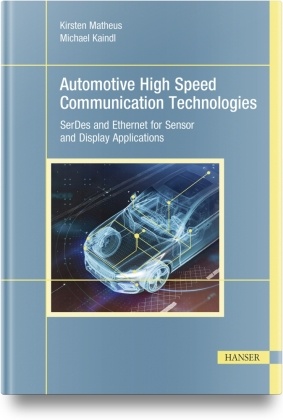
Automotive High Speed Communication Technologies - SerDes and Ethernet for Sensor and Display Applications
| Verlag | Hanser Fachbuchverlag |
| Auflage | 2022 |
| Seiten | 440 |
| Format | 17,8 x 2,9 x 24,9 cm |
| Gewicht | 1152 g |
| Artikeltyp | Englisches Buch |
| ISBN-10 | 3446469184 |
| EAN | 9783446469181 |
| Bestell-Nr | 44646918A |
Rezension:
"Das Buch beleuchtet erstmals ausführlich die technischen Grundlagen für die Anbindung von datenintensiven Komponenten wie Displays und Kameras. [...] Nachrichtentechnische Grundkenntnisse sind dabei für die Lektüre von Vorteil. Durch seine klare und systematische Struktur, ein sehr ausführliches Abkürzungsverzeichnis sowie gut verständliche Einleitungstexte zu jedem Kapitel ermöglicht das Buch aber auch mit der Thematik weniger Vertrauten einen Einstieg in die Welt der Automotive-High-Speed-Kommunikation." Ingo Kuss, elektroniknet, Januar 2023
"Die Anforderungen an Rechenleistung, Software und Kommunikation steigen ständig - so auch in der Automobilbranche. In Fahrzeugen wird der Bedarf an höheren Datenraten durch mehr elektronische Funktionen im Allgemeinen, aber insbesondere durch immer leistungsfähigere (Kamera-)Sensoren, Displays und Hochleistungs-Steuergeräte angetrieben, wie das Buch Automotive High Speed Communication Technologies von Kirsten Matheus und Michael Kai ndl aufzeigt. Das Buch 'Automotive High Speed Communication Technologies' bietet eine ganzheitliche Sicht auf neue SerDes- und Ethernet-Hochgeschwindigkeits-Kommunikationslösungen für Fahrzeuge." Stefanie Eckardt, Hanser automotive, 25.11.2022
The demands for processing power, software, and communication are continuously increasing; in all industries and also in the automotive one. In vehicles, the need for higher data rates is driven by more electronic functions in general, but especially by ever more potent (camera) sensors, displays, and high performance ECUs.
This book provides a holistic view on new SerDes and Ethernet high-speed communication solutions for cars. It addresses core physical components such as cables, connectors, or PCB design, as well as physical layer processing, use-case-specific protocols, and the use cases as such. It is important to the authors not only to explain the technologies, but also to provide context and background in respect to various technical choices. The intent is to help readers understand the current eco-system end-to-end, whether they are new to the automotive industry or experts who want to deepen their understanding on specific items, whether they are working for a car manufacturer directly or any of the suppliers, whether they are already involved or evaluating to get involved.
This is the first book to address the following topics:
- the >10 Gbps Automotive Ethernet technologies IEEE 802.3cy and IEEE 802.3cz
- asymmetric Ethernet
- the new automotive SerDes Standard, the ASA Motion Link
- the MIPI Automotive SerDes Solutions ( MASS )
- power supply over coaxial data cables
- design for testability in an automotive context
